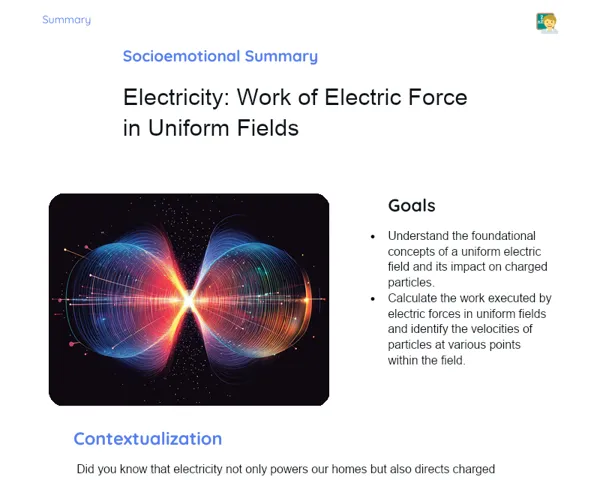Objectives
1. Grasp the idea of the average speed of gas molecules and how temperature influences this measure.
2. Hone skills to calculate the average speed of gas molecules using specific formulas, along with data on pressure and temperature.
Contextualization
Did you know that understanding the average speed of gas molecules can explain everyday things, like why balloons seem to inflate more on a hot day compared to a chilly one? This occurs because increased molecular movement (or average speed) happens with rising temperatures, causing the gas inside the balloon to expand. This concept is not only captivating but also fundamental for various practical and scientific applications, ranging from meteorology to materials engineering.
Important Topics
Average Speed of Gas Molecules
The average speed of gas molecules indicates how fast the molecules are moving within a specific volume of gas. This speed changes with temperature; as temperatures rise, the kinetic energy of the molecules increases, leading to swifter movements. Grasping this concept is crucial for molecular kinetics and understanding gas behavior in varying thermal conditions.
-
Temperature Influence: Temperature plays a pivotal role in directly impacting the average speed of molecules. An increase in temperature leads to an uptick in average speed, per the Maxwell-Boltzmann distribution.
-
Calculation of Average Speed: The average speed of gas molecules can be figured out using the formula v = √(3kT/m), where v is the average speed, k is Boltzmann's constant, T is the temperature in Kelvin, and m is the molar mass of the gas.
-
Practical Importance: Comprehending the average speed of molecules is vital for various applications, including gas storage technology, predicting gas behavior in engineering environments, and in meteorological studies.
Kinetic Theory of Gases
The kinetic theory of gases explains gas behavior as a set of particles in constant motion. It posits that molecular movement is random, and the average kinetic energy of a gas correlates with its absolute temperature. This theory elucidates how macroscopic characteristics of gases, like pressure and volume, arise from the microscopic behavior of molecules.
-
Molecules in Motion: Gas molecules are perpetually in motion, colliding with one another and the walls of their container, which accounts for gas pressure.
-
Kinetic Energy and Temperature: The theory asserts that the average kinetic energy of the molecules is proportional to the gas's temperature, explaining the increased molecular agitation as temperature climbs.
-
Mathematical Modeling: The kinetic theory of gases provides mathematical frameworks essential for predicting gas behavior under varying conditions, which is vital in physics and engineering studies.
Maxwell-Boltzmann Distribution
The Maxwell-Boltzmann distribution illustrates the statistical variation of velocities among gas molecules. It demonstrates that, at a fixed temperature, gas molecules manifest a range of speeds that adhere to a specific distribution. This distribution is crucial for comprehending how gas properties, such as pressure, are influenced by molecular speeds and energies.
-
Distribution Curve: The Maxwell-Boltzmann velocity distribution is a curve representing the probability of encountering a molecule with a specific speed in a gas.
-
Standard Deviation and Temperature: The curve's width (standard deviation) widens with increased temperature, signifying greater variation in molecular speeds at elevated temperatures.
-
Practical Applications: This distribution finds use in numerous practical scenarios, such as designing chemical reactors and grasping thermodynamic properties in the fields of physics and engineering.
Key Terms
-
Average Speed of Molecules: The mean measure of how quickly gas molecules travel within a defined volume.
-
Kinetic Theory of Gases: A theory depicting gases as collections of particles in random motion, explaining their macroscopic properties.
-
Maxwell-Boltzmann Distribution: A statistical representation detailing the velocity distribution of gas molecules at thermal equilibrium.
For Reflection
-
How could insights into the average speed of gas molecules inspire the innovation of gas storage technologies?
-
In what ways can the kinetic theory of gases be leveraged to enhance industrial processes relating to gas?
-
What implications do temperature fluctuations have on systems reliant on gas behavior, such as combustion engines and refrigeration units?
Important Conclusions
-
We delved into how temperature impacts the average speed of gas molecules, which is vital for understanding phenomena like how balloons expand on warmer days.
-
We covered the kinetic theory of gases and the Maxwell-Boltzmann distribution, key theoretical foundations in anticipating gas behavior under varying scenarios.
-
We emphasized the practical significance of these concepts, spanning from engineering applications to weather forecasting, demonstrating how physics is woven into our everyday experiences.
To Exercise Knowledge
- 🎈 Mysterious Balloon: Inflate two identical balloons, one on a hot day and the other when it’s cold. Measure each balloon's diameter and calculate its approximate volume. Compare your findings and discuss the differences. 2. 🕵️♂️ Gas Detective: Use a thermometer to check temperatures at various spots in your home (like near a window and in the lounge). Note the temperatures and speculate on how the average speed of air molecules might differ in those locations. 3. 💻 Computer Simulation: Engage with an online gas simulation that lets you modify the temperature and visually observe the molecules' activities. Describe your observations and connect them to what you've learned.
Challenge
🚀 Gas Engineer Challenge: Imagine you’re an engineer assigned to create a new cooling solution for a city. Using the concept of the average speed of molecules, suggest how your system could efficiently utilize gases to regulate temperatures in various parts of the city, taking into account seasonal climate changes.
Study Tips
-
Revisit crucial formulas and concepts regularly to reinforce your understanding and retention.
-
Make use of visual resources like simulations and videos to picture gas molecule behavior and enhance learning.
-
Engage with peers or online platforms to discuss real-world applications of the concepts studied, aiding in a deeper grasp and interest in the topic.


